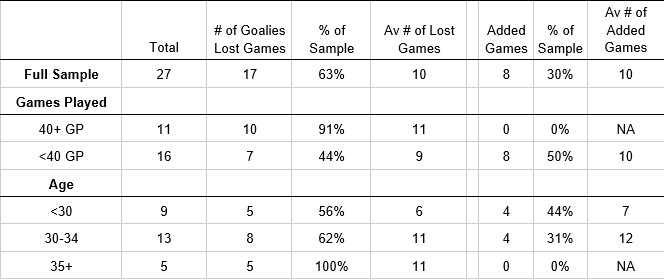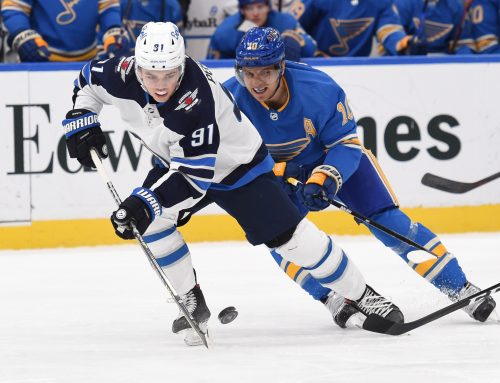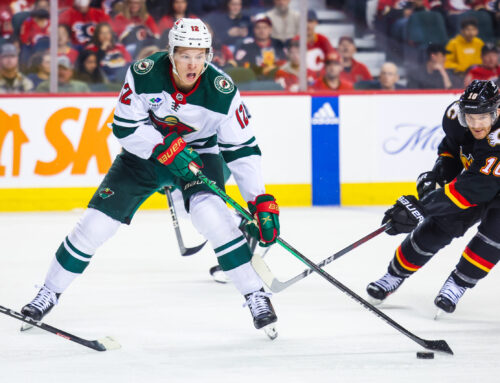Two weeks ago we took a look at Matt Murray and Devan Dubnyk moving cities, and last week, inspired by the Taylor Hall move, we examined big-name wingers on the move over the last several seasons. This week, after some positive comments and questions about goalies we are essentially going to combine these two approaches and get some historical perspective on our goalie moves.
This week on Frozen Tool Forensics: Goalie Moves Past and Present
To start, let's quickly define the kinds of things we are going to be looking at. I think the interesting question here is this: what happens to goalies after they move teams? Do they perform better? Worse? And more specifically what happens to goalies who have been fantasy relevant in their prior season? To really answer these questions for specific goalies we would have to dive deep into their personal histories, their individual numbers, their old team numbers, and their new teams' numbers, as well as roster configurations and coaches' tendencies.
For example, If we wanted to examine Jacob Markstrom now in Calgary it might be helpful to know that he is moving from a Vancouver team that averaged 2.55 expected goals against a game to a better situation in Calgary where they averaged 2.4 expected goals against per game. It might also be good to know that in Vancouver Markstrom was able to start the equivalent of 56ish games per year over the last three seasons, but is moving to a team where David Rittich has started 45-50 games per season over the last two. That might mean more of a timeshare for Markstrom.
We won't be diving into that depth for each of the moves that were made in 2020, but instead taking the Hall approach of looking over the past several seasons for goalies who moved teams and see what patterns emerge. Our primary drivers are going to be usage (games played) and quality (save percentage).
The 2020 offseason saw quite a few goalies move. We have the aforementioned Murray, Markstrom, and Dubnyk, but also Braden Holtby, Thomas Greiss, Robin Lehner (sort of), Jake Allen, Corey Crawford etc. All in all, I took seven of the biggest moves to give us a baseline of data. These guys started what would have been an average of 40 games if they had been able to play a full season (with a range of 28 to 50 games played) before they changed teams, with an average save percentage of .911.
Quick side note: I extended all 2020 goalie numbers to what their 82-game pace would have been so we can have a more even comparison to previous seasons. So that means 2020 goalie games played numbers will look a little different in our data and discussions than in their Player Profiles.
An additional note on process here. I went back digging through season data to try and find goalies who switched teams after playing around 40 games with that first team. Suffice to say there are no databases I could find that allowed me to filter by "did this guy get traded in the next off-season," or "is this the goalies' first year with the team." I ended up having to do some digging through old trade and free agent trackers, and then Player Profile-ing the heck out of the Frozen Tools section to track everything down. All of that is to say I may have missed a few players and my apologies.
First up – some basic sample info. I went back three seasons so looked at goalies who moved teams in the summer of 2017, 2018, and 2019. I further then sorted out any goalie that had played fewer than 30 games to keep it more in line with the sample of goalies we are interested in from 2020. All in all, I reviewed 27 goalie moves (some goalies moved multiple times within this time period).
Some quick data: The average age of the sample is 31, goalies averaged 43 games with their initial team, and 38 after their move, and averaged a .912 save percentage with the initial team and a .910 with the second. In the broadest most general context then it seems like moving teams means fewer games played and a slightly worse performance. We will definitely explore this a bit more.
There also seem to be two major categories of goalies: one slightly younger set where goalies seem to have stepped up from a backup role during their pre-move season (so hit the 30+ game minimum), and then moving to a more prominent role in the second season, and a second set of goalies where a veteran (maybe on an expiring contract, maybe moved to make room for an upstart) ends up on a new team.
With that said here is some data.

The table is a little unwieldy so let's break it down a bit.
For this first section, we are looking solely at the number of games a goalie played. We are comparing the year prior to the move to the year immediately after. If we start with the first row of data, titled Full Sample, (and move left the right) we can see that the total number of goalies sampled is 27, and 17 of those goalies (or 63 percent) lost games played between their pre-move year and the first year in the new location. Those goalies lost an average of ten games. We can also see that eight of the goalies (or 30 percent) gained in games played and that increase was also about ten games on average. The remaining two goalies? They played the same amount.
These data are further broken down by games played the pre-move year (40 plus games played, and less than 40 games played) and by age (under 30, 30-34, and 35+). A couple of things stand out here. Ninety-one percent of goalies who played more than 40 games, lost games after their move, and 100 percent of goalies who were 35 or older and moved lost games. Corey Crawford fits both of those categories so if he were to meet or exceed his pro-rated 46 game pace from 2019-20 he would be a remarkable outlier. Henrik Lundqvist is the only other goalie in our 2020 list who is 35 or older and it really wouldn't be that surprising to see him play fewer games at this point. Markstrom, Murray, and Lehner all played more than 40 games in 2019-20 so seeing them drop a few games would be right in line with these data as well.
On the whole changing teams doesn't look great for adding games, but what light there is comes from young goalies who have played fewer games to start with. 50% of the goalies who played less than 40 games in their pre-move season played more in their new home, and 44% of the goalies under 30 did the same. No one in our list for 2020 meets those criteria though Matt Murray and Jake Allen are the closest. Based on age and prior usage alone, they have the best chance to improve their games played numbers. Murray will hopefully meet that with his opportunity in Ottawa (barring injuries), but the chances are less good for Allen behind Carey Price.
Beyond usage I also looked at quality of performance, using save percentage.

So again, the full sample included 27 goalies, 14 of which (52 percent) saw worse overall save percentages in the post-move year. The average decrease in save percentage was .013 while 13 goalies (48 percent) saw an increase in save percentage with an average of .011.
A couple of interesting points here as well. The distribution of goalies who were 35+ and played over 40 games in their pre-move seasons aligned pretty well with the other categories for increasing/decreasing save percentages, but the average size of those changes is really quite different. The 35-year-old+ group had the highest percent of goalies who decreased their save percentage (60), and they lost it by the largest amount (.017). For the ones whose save percentage got better, it improved by an average of .003, by far the smallest amount of all groups listed. The same trend is true for the goalies that played 40+ games but is a bit less pronounced. So basically being a goalie who played more than 40 games, is over 35, and has moved teams isn't a great place to be.
Again. Crawford fits all of those criteria for 2020 implying that according to these patterns, in addition to losing games his save percentage could also be in trouble. I think a similar case could be made for Lundqvist.
Overall, though, for save percentage there is a pretty even distribution across the continuum with estimated adds or drops of about .013 on average (outside of the 35+ age group).
So, can you do with all of this? Well if we return to our initial example of Markstrom, he is 30 and played a pro-rated 50 games in 2019-20 with Vancouver. According to the trends outlined in these data, it seems likely that he will lose some games played (as 91 percent of goalies who have 40+ games played saw a decrease after they moved). This is also logical in context considering Rittich is still in Calgary and has played 40+ games in the last two seasons. For his save percentage, goalies with his usage were slightly more likely to increase their save percentage in a new home (55 percent improved vs 45 percent decreased), but his age puts him in a category where slightly more goalies have seen a decrease (38 percent improved, vs 46 percent decreased) with a move. That makes Markstrom hard to peg for sure. Slightly unsatisfying I suppose, but if it were satisfying we certainly wouldn't be talking about fantasy goalies.
That is all for this week. Thanks for reading.
For all of the Canadiens reading this, hope you are enjoying your fall. For all of the Americans, you have 11 days left (as of Friday) to vote. Make it happen. Got questions about what is going on in your state? This can help.
Stay safe out there.





 OTT
OTT TOR
TOR MIN
MIN VGK
VGK COL
COL DAL
DAL EDM
EDM L.A
L.A CAR
CAR CHI
CHI STL
STL MTL
MTL N.J
N.J WSH
WSH
